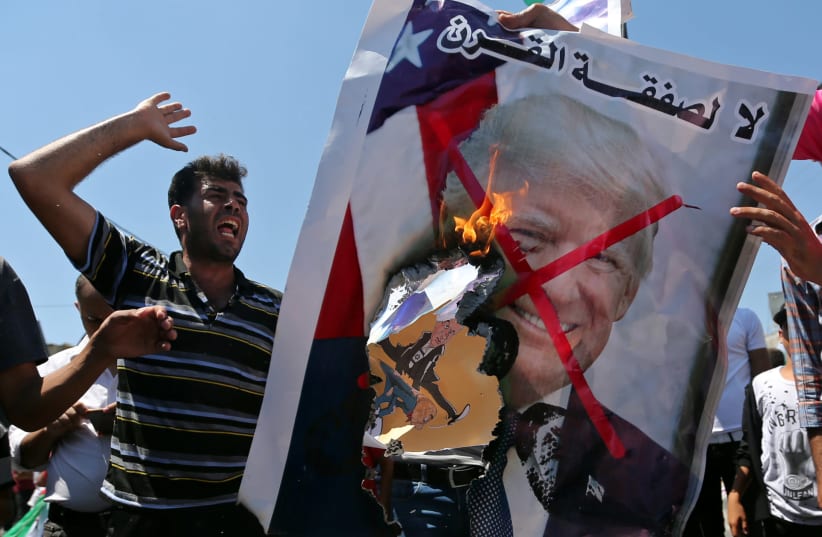None of the three actors in the Israeli-Palestinian conflict envisions peace in the foreseeable future.
Hamas for ideological reasons can’t stomach real peace. It would mean openly acknowledging that the dream of Palestine “from river to sea” is no longer attainable – and by doing so, lose its legitimacy to the Palestinian Authority that is recognized by the international community. Peace making would also mean the end of Iranian military aid, and Turkish and Qatari support for the organization.
Hamas would be threatened by the same marginalization that characterized strong Palestinian factions in the past like the Popular Democratic Front for the Liberation of Palestinians. To sacrifice oblivion for the sake of the Jews is, to say the least, unpalatable.
Even less eager to make real peace is the Palestinian Authority under Mahmoud Abbas. Making real peace would mean Palestinian sovereignty that could not countenance the daily penetration of Israeli security forces, which in close coordination with the PA security forces protects the PA from their common foes – Hamas and Islamic Jihad, by arresting the lion’s share (70%) of their supporters.
Peace threatens the PA and its political elite with nightmarish scenarios once the IDF is forced to withdraw for the sake of peace.
At best, Hamas and Islamic Jihad would be strong enough to engage in a long civil war in areas presently controlled by the PA. The outcome could very well be the division into a Palestinian Judea and Samaria, the former controlled by the Khalaileh – the Hebronites – who form the majority of east Jerusalem and south of it, where Hamas enjoys considerable support, and the Palestinian Judeans from Ramallah northward that will be controlled by Fatah factions and overlords, who will be either divided or act in unison.
Worst case scenario: Hamas and Islamic Jihad would be able to achieve a complete takeover of the PA – as Hamas did in 2007 in Gaza.
Unlike the PLO elite in the past who always found a refuge – first in Amman and Beirut, then in Tunis and finally in Ramallah – the PA’s political elite today has literally nowhere to flee.
Not one Arab country, including Jordan, will offer them refuge, meaning a bleak future under onerous Hamas rule. Abbas and his coterie only have to look at how Fatah supporters fare in the Hamas one-party state of Gaza.
Neither can most Israeli voters envision peace in the near future, as much as they would like to achieve it. Not only are the bitter lessons of Oslo – coined a peace process, but in reality a war process that increased Israeli casualties five-fold and doubled Palestinian casualties – preventing this, but they only have to contemplate the ramifications of replicating Hamas actions along the Gaza border (the Gaza envelope) in the past year to the Green Line between Israel and the PA.
CONSIDER WHAT fires, incendiary bombs and daily to weekly attacks along the security fence between Afula and Jerusalem would mean.
Envisioning the impact on two key strategic points along the way – the Rabin Highway, better known as Route 6, Israel’s largest highway along its critical epicenter in the Dan region, and the Ben-Gurion Airport, Israel’s major international airport nearby – is sufficient to make Israelis pessimistic over the prospects of achieving peace.
The occasional mortar volley would be sufficient to close down the Rabin Highway for long periods of time, paralyzing traffic in the whole Dan metropolitan area, which is already beset by traffic jams, not to mention the crashes that the panic these volleys would elicit.
Incendiary bombs and the occasional mortar launched from places like Budrus, a village six miles away from the Ben-Gurion tarmac, would close down Ben-Gurion Airport or prevent the landing of planes by IATA fiat.
Just these two ramifications of Hamas’s “peaceful” activities would render Israel, like Lebanon since the 1970s, a good place to leave. Ironically, the “hi-techers” and other members of Israel’s economic elite – who live in an area stretching from northern Tel Aviv to Ramat Hasharon, and who overwhelmingly vote for parties that clamor for peace – might be the first to exit.
The beauty from Hamas’s point of view is that they can achieve strategic objectives without directly inflicting Israeli deaths, which would justify Israeli retaliation in the international community.
It is this very absence of the prospects of peace that makes the Trump economic plan so timely.
A seminal article written by Columbia University political scientist Alfred Stepan and Cindy Skach 30 years ago explains why. They showed that societies that enjoy a per capita GDP of $8,000 (double that amount today) do not engage in violent political behavior, either because they have too much to lose, or are too used to air-conditioned activities at the mall, or both.
Israeli-Arab behavior in the Second Intifada demonstrates the validity of this finding. The blood curdling chants of khaybar, khaibarr ya yahud, jeish Muhammad saya’ud – warning the Jews that they will be meeting the same fate they encountered against Muhammad’s army – and the many near-lynches perpetrated against Jewish fellow citizens had lasted 10 days, while the intifada lasted at least three years beyond that.
Either Israeli-Arabs felt that they had too much to lose, or, as activists in the Arab parties often complain, they spend considerably more time in the shopping malls than in demonstrations. Israel’s Arab citizens have not been involved in widespread violence since then.
Engendering economic well-being does not solve deep-seated political conflicts. But it holds the prospects of voicing the differences in less violent ways. Trump’s plan might then save lives of Israeli Jews and Arabs alike – provided, of course, that it is not followed by a delusional peace process.
The writer is a senior research associate at the Begin-Sadat Center for Strategic Studies.
